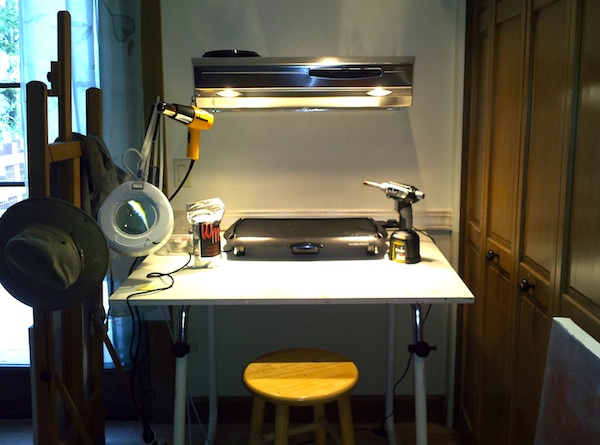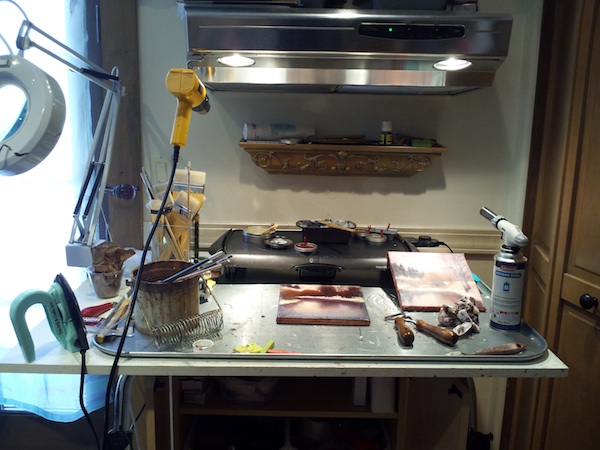Lately, I have been experimenting with encaustic wax painting.
For those of you who don’t know, encaustic painting is an ancient art form of ‘hot wax painting’ that dates back thousands of years. In Greek, the term “encaustic” means to “burn in” and is used to describe both the paint itself, and the method for using it.
But because of this ‘burning in’ technique, special studio precautions must be taken to ensure the artist’s safety. Proper ventilation is most important because as the encaustic wax medium heats up to its working temperature, it creates noxious fumes.
Recently, I set up my own encaustic corner within my small studio space. With a little advice from R & F Paints, here’s how I did it…

I don’t have a lot of extra studio space, but my old drawing table fit perfectly in this corner.
Then, my electrician was able to easily vent the range-hood from the inside wall to the outside of the studio. We tested for airflow by simply lighting a stick of incense and watched the smoke rise into the range-hood. Honestly I wish the hood was a little bit lower, but I had some restrictions that wouldn’t allow for it. While working with the wax, I also make sure to keep a window cracked open for replacing fresh air.
Here’s what I bought to get me started:
- The range-hood is by Allure from Home Depot.
- I also bought an inexpensive heat gun and blow torch for fusing from Home Depot.
- The handy Hamilton Beach electric griddle with a temperature control is for melting the wax medium and pigments.
- I keep my wax at about 180 – 200 degrees. I want the wax hot enough to flow easily from my brush to the painting, but not so hot that it smokes.
- According to R & F Paints, at a higher temperature (around 200-220°F), which is the working temperature of encaustic, it is important to have ventilation.
- The fumes can be irritants, causing headaches, nausea, and respiratory problems. I use a flat thermometer to monitor the heat.
- Wax medium and pigments.
- Metal tins for melting wax.
- Natural bristle brushes (synthetics will melt) are affordable and available at hardware stores or art supply stores.
In the photo below, you can see that I later added a galvanized oil drip pan that I found in an auto parts store. The drip pan helps make my work surface more heat resistant and fire retardant.

I am fascinated with the luminous, organic quality of encaustic wax. The wax has a mind of its own, yet it can be fused or re-melted to create a variety of lustrous effects.
Encaustic wax goes from a liquid to solid state and back again in seconds, which allows layers to be built up immediately, without any drying time. Once cooled, the painting can be revised and reworked with heat at any time – minutes or years later.
Encaustic wax painting offers something for everyone, whether you enjoy drawing, painting, photography, printmaking or even sculpture!
To learn more about venting your studio for encaustic > http://www.rfpaints.com/images/stories/pdfs/tech_enc_venting_studio.pdf
For encaustic supplies please visit these fine retailers:
- http://www.rfpaints.com/
- http://www.waxworkswest.com/
- http://www.danielsmith.com/
- http://evansencaustics.com/
- http://www.encausticpaints.com/
You can see my art on my website, LoriMcNee.com, and let’s meet on Facebook Fine Art Tips Facebook Fan Page, on Twitter, Google Plus and on Pinterest. Be sure and check out and my fine art prints and notecards on Fine Art America.! ~Lori








i have just also begun working with encaustic and find your space very similar to mine, and i also have about the same exhaust system. i love the idea of the oil drip pan… i am going to go to our local auto supply shop and get one for my table. thanks for that, and for a most useful post.
georgia
Hello Georgia, the drip pan really is great! Glad this post was helpful to you…
Wow! It was so exciting to see your new encaustic set up! I’m not very familiar with the process but am looking forward to learning more! I can’t wait to see what you create with your new area!
Thanks Molly, I am getting ready to start a whole new series. I will keep you posted!
Lori
I like your work space – see you discovered the oil drip pan as a great surface to work on – and affordable too!
Yes! I love that drip pan. It has really captured a lot of messy wax and saved my worktable, plus it is burn proof!
Cheers,
Lori
Thanks for the explanation, and the visual aid of the photos 😀
Now, I really want to see a real encaustic painting…
I sounds so colorfull and luminious.
***Pyrane****
Oh, I hope you get a chance to see some encaustic paintings in real life. They truly are beautiful and luminous. Thank you for commenting!
Did you vent the range hood to the outside?
Yes I did. It vents through the wall that it is attached to…